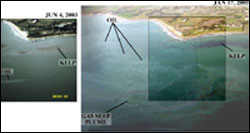Oiled birds prompt study by UCSB experts

Aerial photos off Coal Oil Point of a small portion of the Coal Oil Point seep field. Typical oil emissions from this seep area are shown in the left image (Current is to west, left). Right image shows typical conditions observed since the winter storms (Current is to east, right). Photos courtesy of Ira Leifer, UCSB, and Chris McCullough, Calif Dept of Conservation, Division Oil and Gas.
Oil-coated birds turning up on southern California beaches in recent weeks have raised concern about potential oil sources. The Coal Oil Point seep field, located offshore and adjacent to the University of California, Santa Barbara, is one of the biggest natural marine oil and gas seeps in the world and is the predominant source of oil to southern California waters. Extensive oil slicks have been observed near Coal Oil Point since the recent severe storms pummeled the region in January. These slicks are significantly larger than typically seen in the area, including just before the storms. Since 1994, scientists at UCSB have been studying the Coal Oil Point seep field, including using sonar to map the seepage.
Recently UCSB scientists participated in aerial surveys of the northern channel. Current oil emissions appear to be many times pre-storm levels, estimated at 4,200 gallons per day. (Photos at www.ia.ucsb.edu/pa/1233-seep/)
New areas of seepage have appeared and were confirmed by boat surveys. Scientists at UCSB are studying a possible relationship between the storms and these increased oil emissions.
Bruce Luyendyk, professor of marine geophysics at UCSB, poses two hypotheses for the apparently vast increase in oil seepage following the storms. “The rain may have changed the subsurface hydrology, creating higher driving pressure of the seepage,” he said.
A second hypothesis is that sea floor tar and sediment blockages may have been removed by the storms, allowing an increase in the flow.
“Both oil and gas are coming out,” explained Ira Leifer, a scientist with UCSB’s Marine Science Institute. “Gas drives the oil because it is lighter,” he said. “We can measure the amount of gas with sonar because the sonar’s sound bounces off the bubbles. We also measure how much oil is escaping with the gas.”
Media Contact
More Information:
http://www.ucsb.eduAll latest news from the category: Ecology, The Environment and Conservation
This complex theme deals primarily with interactions between organisms and the environmental factors that impact them, but to a greater extent between individual inanimate environmental factors.
innovations-report offers informative reports and articles on topics such as climate protection, landscape conservation, ecological systems, wildlife and nature parks and ecosystem efficiency and balance.
Newest articles

Zap Energy achieves 37-million-degree temperatures in a compact device
New publication reports record electron temperatures for a small-scale, sheared-flow-stabilized Z-pinch fusion device. In the nine decades since humans first produced fusion reactions, only a few fusion technologies have demonstrated…

Innovative microscopy demystifies metabolism of Alzheimer’s
Researchers at UC San Diego have deployed state-of-the art imaging techniques to discover the metabolism driving Alzheimer’s disease; results suggest new treatment strategies. Alzheimer’s disease causes significant problems with memory,…

A cause of immunodeficiency identified
After stroke and heart attack: Every year, between 250,000 and 300,000 people in Germany suffer from a stroke or heart attack. These patients suffer immune disturbances and are very frequently…





















